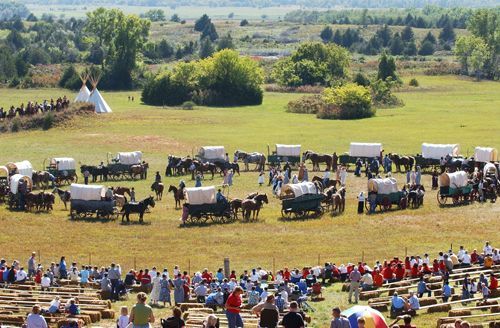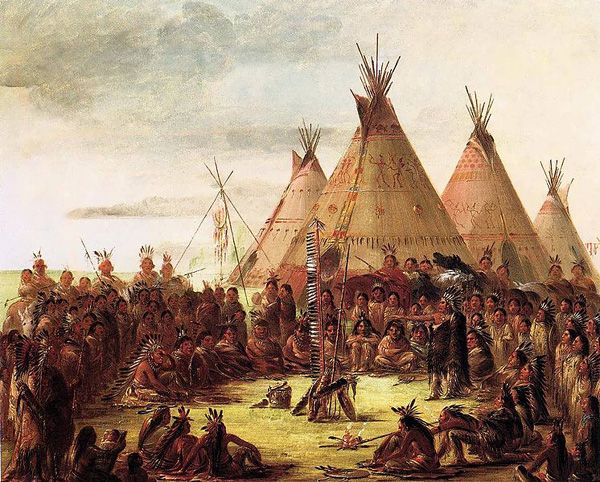
Echoes on the Prairie: Medicine Lodge and the Shifting Sands of American Legend
America is a nation woven from threads of myth and memory, a tapestry where heroic narratives of pioneers and trailblazers often intertwine with darker, more complex tales of conquest and displacement. These legends, whether whispered around campfires or enshrined in textbooks, shape our understanding of who we are. Yet, some sites, though pivotal, remain less etched in the popular imagination than others. One such place, a vast, windswept expanse on the Kansas prairie, is Medicine Lodge – a name that, for those who know its story, evokes a profound crossroads in the forging of the American West, a place where the grand legends of expansion collided head-on with the enduring realities of indigenous sovereignty.
The story of Medicine Lodge isn’t just a historical footnote; it is a microcosm of the American experience, embodying the nation’s aspirations, its tragedies, and its persistent struggle for reconciliation. It stands as a silent testament to a moment when two vastly different worlds – the rapidly expanding United States and the sovereign nations of the Plains – attempted, however imperfectly, to find a path to peace.
The Landscape of American Legend: From Frontier Dreams to Bitter Realities

The very concept of "American legend" is deeply rooted in the nation’s westward expansion. From the moment European settlers first gazed upon the vast continent, the idea of a limitless frontier, ripe for discovery and development, took hold. This was the era of Manifest Destiny, a belief that it was America’s divinely ordained right to expand across North America. Legends sprang from this ideology: the rugged individualist pioneer taming the wilderness, the cowboy embodying freedom and self-reliance, the gold prospector striking it rich. These narratives, often romanticized, painted a picture of relentless progress and ingenuity, shaping a national identity built on optimism and an unyielding spirit.
However, these cherished legends often obscured a harsher truth. The "empty" frontier was, in fact, home to scores of indigenous nations, who had inhabited and stewarded the land for millennia. Their presence was an inconvenient truth for the narrative of a pristine wilderness awaiting settlement. The expansion, therefore, was not merely a journey into the unknown but an invasion, leading to decades of conflict, broken treaties, and the systematic dispossession of Native American peoples. The "Indian Wars" became a tragic chapter in American history, marking the violent collision of two irreconcilable visions for the land.
It is against this complex backdrop that the Medicine Lodge Peace Treaty Council of October 1867 unfolds, not as a simple tale of triumph or defeat, but as a poignant drama of hope, misunderstanding, and ultimate failure.
Medicine Lodge: A Gathering of Nations and a Clash of Worlds
In the autumn of 1867, the Medicine Lodge Creek in south-central Kansas became the unlikely stage for one of the largest peace councils ever held between the U.S. government and the Plains tribes. The Civil War had just ended, unleashing a torrent of westward migration and accelerating the conflict between settlers, railroads, and the Native American nations whose lands lay in the path of expansion. The U.S. government, seeking to quell the escalating violence and secure routes for the transcontinental railroad, dispatched the Indian Peace Commission, a formidable delegation of generals and politicians, including General William T. Sherman and Senator John B. Henderson.
They came to negotiate with the powerful Southern Cheyenne, Southern Arapaho, Comanche, Kiowa, and Plains Apache nations – tribes who had fiercely resisted encroachment on their ancestral hunting grounds. For weeks, thousands of people gathered: U.S. commissioners, military escorts, journalists, traders, and an immense encampment of Native American families, their tipis stretching for miles along the creek. The air hummed with anticipation, apprehension, and the smell of woodsmoke and buffalo hide.
This was no ordinary meeting. It was a grand council, steeped in the traditions of diplomacy and ceremony that had governed intertribal relations for centuries. But beneath the surface of shared pipes and formal speeches lay a fundamental chasm of understanding. The U.S. commissioners saw land as a commodity to be bought, sold, and surveyed; their primary goal was to confine the tribes to reservations and open the vast buffalo ranges for white settlement. The Plains tribes, conversely, viewed the land not as property but as the source of life, sacred and inseparable from their identity, culture, and very survival. They were reluctant to give up their freedom to roam and hunt the buffalo, which was the cornerstone of their existence.
Voices from the Prairie: Eloquence and Desperation

During the council, the Native American chiefs, despite facing immense pressure, spoke with remarkable eloquence and clarity, their words echoing through history as powerful statements of sovereignty and cultural identity.
One of the most famous speeches came from Satanta, the Kiowa chief, known as the "Orator of the Plains." He passionately defended his people’s way of life and their connection to the land:
"I love the land and the buffalo, and I will not part with it. I want to live as my fathers lived, and die where they died." He continued, "I have heard that you intend to settle us on reservations and make us cultivate the soil. I do not want to settle. I love to roam over the prairies; there I feel free and happy, but when we settle down we grow pale and die." Satanta’s words encapsulated the deep-seated fear of cultural annihilation that loomed over the tribes.
Another powerful voice was Ten Bears, a Comanche chief, who spoke with a profound connection to his ancestral lands:
"I was born upon the prairie, where the wind blew free and there was nothing to break the light of the sun. I was born where there were no enclosures and where everything drew a free breath. I want to die there and not within walls." His speech highlighted the spiritual and existential importance of their freedom and mobility.
Despite these impassioned pleas, the momentum of U.S. expansion was overwhelming. The commissioners offered annuities – food, clothing, and tools – as an incentive for the tribes to sign away their vast hunting grounds and move to designated reservations in Indian Territory (present-day Oklahoma). Under duress, and with the grim realization of the military might arrayed against them, the tribes reluctantly signed the treaties of Medicine Lodge.
The Treaty’s Aftermath: Broken Promises and Enduring Scars
The ink was barely dry on the treaties before the promises began to unravel. The U.S. government, despite its commitments, often failed to deliver the promised annuities or to protect the reservation boundaries from encroaching settlers and buffalo hunters. The buffalo, upon which the Plains tribes’ survival depended, were systematically slaughtered, driven to near extinction by commercial hunters and as a deliberate strategy to starve the Native Americans into submission.
The tribes, finding their traditional way of life impossible on the meager reservations and seeing their sacred lands continually invaded, often resisted. This resistance led to further conflict, culminating in the Red River War of 1874-75, which effectively ended the last vestiges of independent Plains Indian power. The treaties of Medicine Lodge, intended to bring peace, instead laid the groundwork for further displacement, cultural destruction, and the ultimate confinement of these proud nations.
The legend of Medicine Lodge, therefore, is not one of triumphant peace but of tragic irony. It represents a pivotal moment when the U.S. government, ostensibly seeking a diplomatic solution, imposed a vision of the future that was utterly incompatible with the indigenous way of life, leading to decades of suffering and the near eradication of their cultures. It’s a legend that forces us to confront the darker side of American expansion, challenging the simplistic narratives of Manifest Destiny and revealing the immense human cost of nation-building.
Medicine Lodge Today: A Site of Remembrance and Reconciliation
Today, the Medicine Lodge Peace Treaty Site and Museum stands as a solemn reminder of this crucial historical event. The original council grounds are preserved, marked by interpretive signs and monuments. The museum, located nearby, houses artifacts, documents, and exhibits that tell the story of the treaty, the tribes involved, and the subsequent history of the region.
Perhaps the most compelling testament to the site’s enduring significance is the biennial Medicine Lodge Peace Treaty Pageant. Since 1927, this elaborate outdoor theatrical production, involving hundreds of local volunteers and often featuring descendants of the original tribes, recreates the momentous council. It is more than just a historical reenactment; it is an act of communal remembrance, a way for the local community to grapple with its past and to honor the complex legacy of the treaty.
The pageant and the site itself serve as vital educational tools, encouraging visitors to look beyond the romanticized legends of the West and to engage with the nuanced, often painful, truths of American history. It prompts reflection on themes of sovereignty, cultural identity, broken promises, and the long road toward reconciliation.
Conclusion: Reclaiming the Full Spectrum of American Legend
The legends of America are not monolithic. They are a rich, often contradictory, collection of stories that speak to our highest ideals and our deepest flaws. The tale of Medicine Lodge is a powerful example of this complexity. It is a legend not of a single hero or a clear victory, but of a profound encounter between peoples, a moment of fragile hope overshadowed by the relentless march of history.
By remembering Medicine Lodge, by confronting the truths it embodies, we enrich our understanding of American identity. We acknowledge that the forging of a nation involved not just triumph, but also immense loss and injustice. In a world grappling with historical injustices and the enduring legacies of colonialism, sites like Medicine Lodge offer invaluable lessons. They remind us that true peace and understanding can only emerge when all voices are heard, when history is acknowledged in its full, unvarnished complexity, and when the legends we tell ourselves reflect the complete, sometimes painful, story of who we are. The echoes of those speeches on the Kansas prairie continue to resonate, urging us to listen, learn, and strive for a more just and inclusive future.


